When planners at WED Enterprises were selecting the initial lineup of pavilions for Epcot Center’s World Showcase, they knew that Germany would be included. This decision might seem obvious, considering the nation’s prominence on the world stage, as well as its familiarity to American audiences. Disney’s key reasons for including Germany, however, were far more pragmatic.
The Imagineers knew that World Showcase would need a large-scale dining location, and the Oktoberfest theme that Germany presented would be perfect for that purpose. Perhaps most importantly, they also knew that there was a legion of German corporations, manufacturers, and exporters that would be keen to sign sponsorship deals. In those cash-strapped days of Epcot’s creation, sponsorship money was of the greatest importance, and, in fact, many of the park’s very first sponsors were for the German pavilion.
One rarely mentioned aspect of the pavilion is that when it was designed and created, Germany was still a nation divided. While the area in Epcot was promoted and referred to as simply “Germany”, it’s fairly clear that it was meant to be West Germany. Even more specifically it was designed to draw heavily on the traditions of Bavaria and neighboring states in the southern German regions.
There were several reasons why this choice might have seemed logical for the Imagineers. Southern Germany, home of the Black Forest and the so-called “Romantic Road” sightseeing route, is often evoked in America to represent historic Germany. It is the homeland of many of the fairy tales that inspired Walt Disney’s films, and has retained much of its medieval charm as opposed to the more industrialized north.
But perhaps the most obvious reason to choose the villages of southern Germany as the inspiration for a German pavilion, aside from a general sense of Gemütlichkeit, was the opportunity presented to Disney designers by the region’s ornate and fantastical Baroque architecture. The elaborate Baroque style would give Imagineers something to really sink their teeth into; it’s a type of design that, much like the best of Disney tradition, exists somewhere between the real and the fantastic.
Baroque design, which began to emerge in Italy around 1600, developed as a response to the Protestant Reformation that had swept through German regions. The Protestants built simple buildings, to reflect their simpler forms of worship, and in defiance the Catholic Church began to decorate their own cathedrals with wild excess and fanciful detail. In Germany this aesthetic was concentrated in the largely Catholic south, and so this region became the focus for Disney artists.
While the pavilion represents a variety of styles from the 13th through the 17th centuries, these elements were mixed and matched by Imagineers to fit the scale and needs of the pavilion. WED artists toured throughout Bavaria, meaning that a single facade in the pavilion could possibly reflect several different buildings from across Germany. The use of elements from different eras allowed for the sense of historical layering that is present in old cities, although Disney claimed that their village was more charming than its real-world counterparts because of the lack of modern buildings and “signs of decay” that could distract from the architecture.
Guests approaching the Germany pavilion are immediately immersed in the sensations of a German platz. The smell of the food, the sight of the castle and the colorful storefronts, and the sound of a carillon in the clock tower combine to evoke a Germany that, while being completely artificial, feels “true”.
The cobblestone plaza, surrounded by shops, is backed by the fortifications of a medieval castle. This is modeled mainly on Burg Eltz, located on the Elzback River, and Burg Stahleck, located on the Rhine. These castles both date to roughly the 12th century, and were thus designed to survive siege warfare; the battlements that can be seen protruding from the castle wall were meant to make it easier for defenders to pick off invaders.
In the plaza below sits a central fountain, out of which rises a column featuring a statue of St. George and the dragon. Monuments to St. George, the patron saint of soldiers, are common in Bavaria, and the tale of the saint slaying the dragon dates to at least the 11th century. According to legend, St. George slew the creature while on a pilgrimage in the Middle East and his story was a favorite of soldiers returning from the Crusades. Epcot’s version of St. George – modeled after a similar monument in Rothenburg – might look to be of great vintage, but he’s merely sculpted fiberglass painted to look like stone.
The fountain that St. George guards is also a sight familiar in German villages; in medieval times even wealthy figures could not afford to have water pumped directly into their houses, so these public water fountains became central locations in the community for social activity. Here, in Epcot, it serves a different purpose – as a perch for park-goers waiting for their table at the Biergarten.
The most prominent feature overlooking the platz is the clock tower, which appears to be an amalgam of towers from the city of Freiburg, including the Schwabentor and Martinstor. The clock, a unique design created for World Showcase, plays a show every hour. A mechanical rooster emerges and begins the show with a flutter of its wings, after which statues of a boy and girl in Bavarian dress appear to hammer out the hour on a large bell. A melody, composed specially for Disney, plays out on a glockenspiel in the tower.
The buildings surrounding the platz contain a number of distinctive shops, but while their facades are often patterned on real-world structures, the interiors of the shops were custom designs created to compliment the merchandise contained therein. Disney designers took the pavilion’s shops very seriously, insisting that items sold there had to not only be authentic and made in Germany, but also must be things that American guests and international travelers would identify as uniquely German.
WED staff toured German art shows, craft fairs, and factories in search of suitable wares for the pavilion. The tradition of German craftsmanship proved especially apparent in Bavaria, where the harsh winters had long forced people to earn a living indoors for much of the year. The Bavarian people therefore became master crafters of woodwork and glass items, emerging when it became warm to travel and sell their goods.
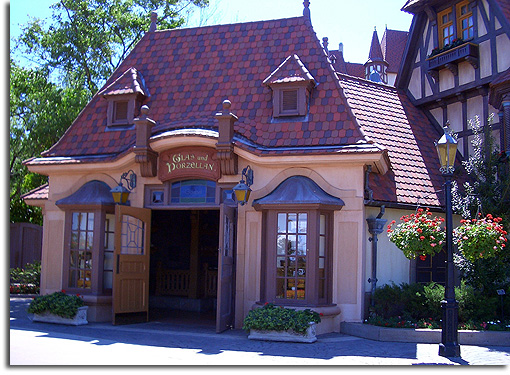
Glas und Porzellan – the shop of an artisan
This tradition is reflected in the shops of the Epcot’s Germany, beginning, to the far left of the pavilion, with Glaz und Porzellan. Sponsored by Goebel, which began as a family business in 1871, the shop was intended to showcase the famous Hummel ceramic figures as well as glassware, dinnerware and cookware. Based on drawings by a young German nun named Berta Hummel, the cherubic figurines were to be crafted on the premises by a Goebel artisan who was originally slated to work two-week stints in the shop at least five or six times a year. The shop’s interior was crafted for this purpose; a demonstration area where the artist could work was separated from guests by a carved wooden railing. The unassuming décor inside, as well as the humble façade facing the promenade, was meant to evoke an artisan’s workshop.
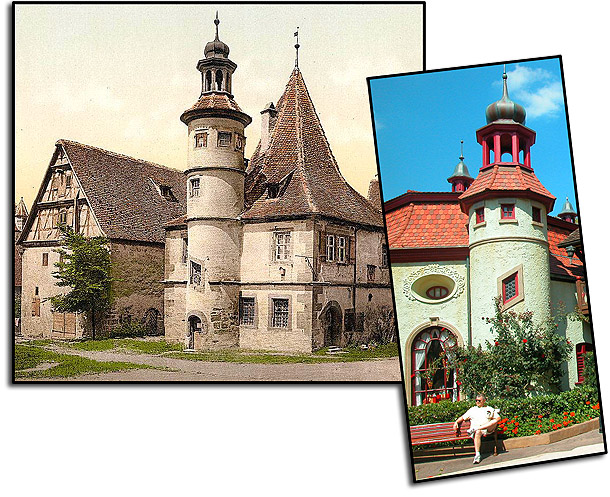
Porzellanhaus (R), now known as Die Weihnachts Ecke, evokes the tower of Rothenburg’s Hegereiterhaus (L)
In the next attached building was the Porzellanhaus. Designed to showcase Hutschenreuther china, this building was far more lavish than its neighbor; it was described as having “deep pile carpets” and “glittering chandeliers”, and featured an octagonal vaulted ceiling. These features were meant to mirror the opulence of the china and porcelain items for sale, and this was carried over to the exterior treatment as well. Elements of the structure, such as the faux spiral staircase topped by a domed cupola, resemble the Hegereiterhaus, built in Rothenburg in 1591.

The Sussigkeiten (L) resembles this bicycle shop in Rothenburg (R)
The Sussigkeiten, built to house a bakery and sweets shop, resembles a number of buildings from Rothenburg that utilize half-timbered construction techniques. Known as Fachwerkhäuser, this style is prominent in southern Germany and can be seen in several of the Germany pavilion’s facades. These buildings were common in medieval northern Europe, and were popular where good timber was plentiful but stone and skilled masons were scarce. Hewn timbers were used to build the structural frames of these houses, which were then filled in with rock or other materials.
Some other features of the Sussigkeiten are common in Bavaria and appear throughout the Germany pavilion. Its steeply pitched roof is designed to more easily deflect snow in winter; with the region’s heavy snow, roof collapses proved a common hazard with less-sound medieval construction. In this and other buildings of the pavilion, upper-floor windows are extremely small. Aside from aiding in the designers’ use of forced perspective, this reflects the real-world need for small upper-floor windows to keep out the icy winter air.
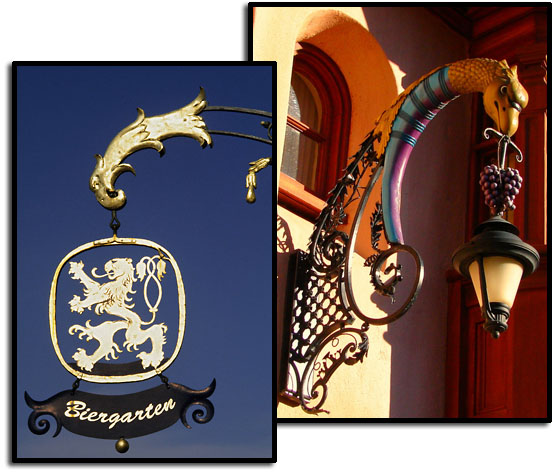
Decorative signs in Epcot (R) and Rothenburg (L)
Next to the Sussigkeiten is the Weinkeller, appropriately themed to a German wine cellar. The facility was built to showcase the 250 varieties of white wine produced by sponsor H. Schmitt Söhne; with German soil and growing conditions best suited to white grapes, at the time of Epcot’s opening around 80% of German wine was white.
Between the Weinkeller and the Biergarten is a building that for many years remained empty. Now a crystal goods shop, it was originally intended to house a German tourism office. Its façade is patterned on the Römer, the 15th century city hall (Rathaus) that sits on Frankfurt’s Römerberg Platz. An important Frankfurt landmark since its purchase from the wealthy Römer family more than 600 years ago, its current Gothic Revival façade dates to around 1900. It was largely destroyed by bombing during World War II and subsequently rebuilt. The front balcony, added in 1900 and featured at Epcot, is used in Frankfurt as a public stage for honored guests and important ceremonies.
In Germany, the Römer houses the city hall and upper-floor rooms where newly-crowned Holy Roman Emperors would hold banquets. At Epcot, it was planned to hold a medieval city hall with suits of armor, coats of arms, and other medieval relics. An “impressive show” was intended to encourage guests’ interest in German travel opportunities, so naturally there would also have been a tourism desk present with travel agents ready to help make arrangements.
The three-story Biergarten building next door was to contain the two major features of the Germany pavilion – a massive dining facility and a picturesque river cruise attraction that was never built. The building’s exterior resembles a similar facility, dating to the 14th and 15th centuries, in Rothenburg ob der Tauber.
While a traditional German beer hall would have been inadequate to Disney’s capacity needs, they managed to transfer the experience into a larger, three-tiered dining area that, courtesy of Imagineering illusions, appears to be located in an outdoor plaza after nightfall. Artificial trees, decked out with autumnal colors, ring the area while a full-sized waterwheel turns in the distance. A projected moon floats overhead, shining down on a series of interior facades that mimic 16th century Rothenburg.

Inside the Biergarten
A central stage provides performance space for a brass band to make several nightly appearances playing a variety of polkas and waltzes. Original plans called for a seven-piece brass band to play 30- to 40-minute sets five times a night, with supplemental performances on melodic cowbells and Alpen Horn. These 15-foot wooden horns were originally designed to aid communications in the Alps before they were adapted for musical purposes.
To enter the Biergarten, guests pass through a large stone archway. But original plans called for the adjacent archway to lead to a completely different experience – a simulated cruise down the romantic waterways of the German countryside. Along the way, guests’ boats would pass miniature tableaus of landscapes from German history and prominent modern areas. Visitors would see historical sites and castles, travel through the Black Forest, industrial centers such as the Ruhr Valley, and cultural and recreational sites such as Heidelberg and the Oktoberfest. Alas, the cruise down the Rhine and other German rivers never materialized as promised.
Three more shops on the platz complete the Germany pavilion. First is Der Teddybär, a toy store with a carved wooden interior that showcased a number of models, dolls, and stuffed animals by renowned German toy designers Steiff. Aside from utilizing half-timbered design similar to the Sussigkeiten, Der Teddybär features another important aspect of Bavarian architecture – jetties, or cantilevered floors that protrude out farther than the floor below.
Jettying served a number of purposes for the medieval builder. Often, the lower level of a medieval building would be used for an open shop, and so the shelter provided by an overhanging structure helped shield one from the elements. In areas where structures were taxed by the square footage of ground floors, this procedure allowed for large upper stories to be built on a small footprint. Jettying also allowed for more spacious buildings to be built along narrow medieval streets. The building housing Der Teddybär is double jettied. The decorated horizontal beam, known as a jetty bressummer, supports the floor above it; the bressummer in turn is supported by the floor below as well as the curved jetty brackets that can be seen lined up along the façade.
Passing through Volkskunst, a shop containing clocks, music boxes, and other mechanical crafts as well as candles and pewterware, guests would arrive at Der Bücherwurm (now called Das Kaufhaus). This bookshop, which also featured sheet music of pieces by great German composers as well as reproductions of works by prominent German artists, was housed in a replica of Freiburg’s Historisches Kaufhaus.
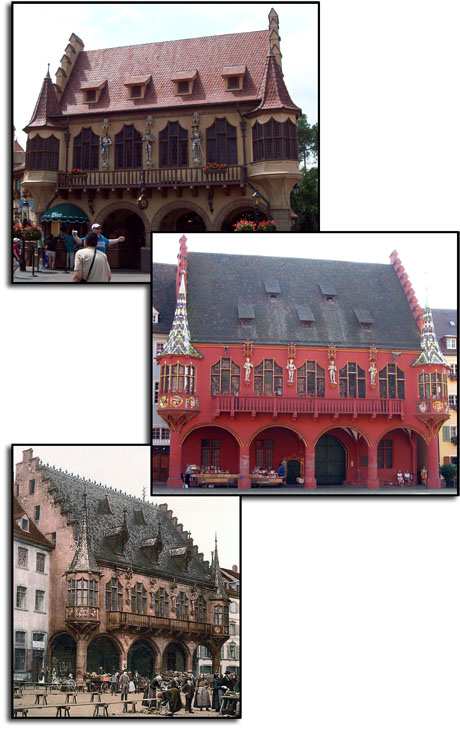
Epcot's Kaufhaus (top) more closely resembles this older depiction of Freiburg's Kaufhaus (bottom) instead of its current, bright-red appearance (center)
Sitting on the Münsterplatz in Freiburg, this medieval merchants’ hall was constructed between 1520 and 1530. Its façade features statues of four Hapsburg emperors, “local boys made good” who had gone on to rule the Holy Roman Empire. The two-story replica at Epcot features identical statues, but because the building had to be scaled down for Disney’s purposes, Emperor Maximilian was omitted. Disney artists had difficulty sculpting the figures, as the initial reference photographs they were provided were taken from ground level. This distorted the visual perspective, and made it impossible to accurately re-create the emperors. Disney had to contract with a local photographer in Freiburg who rented a cherry picker to get face-to-face with the statues and take close-up shots for the Imagineers to use as reference.
Epcot’s representation of Germany is, of course, absurd if one considers it as a distillation of an entire nation. Critics would no doubt point at the artifice of its pristine condition, and its gingerbread-fantasy selection of architectural details. But a deeper look indicates just how seriously WED took its research, and how it incorporated a massive amount of real-world detail into even this idealized version of a Bavarian town. Rather than simply mimicking existing structures, the Imagineers seem to have selected the elements that made the most aesthetic impact and combined them as the WED art directors saw fit. It’s idealized reality, but its emulating reality nonetheless.
And that is Epcot’s Germany. Now that you know the details, why not grab a stein of your favorite beverage, perhaps some strudel from the Sommerfest snack stand, and have a seat in the platz? Take a look at all the detail that the Imagineers included in the pavilion, and think about the skill required to blend all these disparate elements into a working whole. Listen to the carillon chime the hour, and make some reservations at the Biergarten. You’ll want to stay a while!
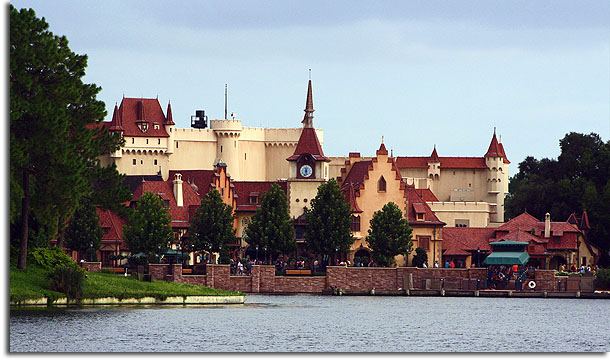














you are my hero. i’ve been subscribed/reading your posts for over a year. just wanted you to know that all of the hard work/time/money you invest is appreciated.
Excellent article. Probably the most well-researched item on EPCOTs Germany I’ve yet seen. But I’m tired of hearing about the awesome Rhine boat ride that was never built – maybe we should start a Facebook group/petition?
“Get Betty White to build the Rhine River Cruise!”
(anyone?)
This was a great article! You help me appreciate Disney all the more. Thanks to you, next time I visit this pavilion I’ll slow down and pay attention to detail.
The level of detail WED put into the German pavillion is only outdone by the research you put into documenting it! Great job!
Well done. Have i seen this before?
Great article! I’m German myself, so it’s almost embarrassing that I learned a great deal reading it….. Thanks!
Excellent article! The research that went into the WS pavilions, and the resulting level of detail, always astounds me.
Excellent research MC. This deep dive into history is something I’m afraid is an “endangered species” these days. They really took the details seriously and in this pavilion they contribute to a great overall composition. They also had time to develop the idea properly. I wonder how far the current merchandise mix has strayed from the intent.
[…] City, U.S.A. examines the Germany pavilion in Epcot’s World Showcase including the Biergarten! Grab a snack from Sommerfest and check […]
Wow! Beautifully written. Kudos!
One of the best if not “the best” written article about Epcot’s Germany. Totally enjoyed the phots depicting the Germany landmarks in relation to the buildings in Epcot’s Germany. A Big thumbs up !!!
Splendid work!
[…] #split {}#single {}#splitalign {margin-left: auto; margin-right: auto;}#singlealign {margin-left: auto; margin-right: auto;}.linkboxtext {line-height: 1.4em;}.linkboxcontainer {padding: 7px 7px 7px 7px;background-color:#eeeeee;border-color:#000000;border-width:0px; border-style:solid;}.linkboxdisplay {padding: 7px 7px 7px 7px;}.linkboxdisplay td {text-align: center;}.linkboxdisplay a:link {text-decoration: none;}.linkboxdisplay a:hover {text-decoration: underline;} function opensingledropdown() { document.getElementById('singletablelinks').style.display = ''; document.getElementById('singlemouse').style.display = 'none'; } function closesingledropdown() { document.getElementById('singletablelinks').style.display = 'none'; document.getElementById('singlemouse').style.display = ''; } Cheap Prices Large Ceramic Rooster Figurine Cucina Italian CollectionRooster Photos And Figurines – Perfect For Nation DecorOggi Ceramic Rooster Utensil Holder, Antique WhiteOggi Ceramic Rooster Pump Dispenser, Antique White[Reproduced] a famous modern Chinese ceramic artist home directory.My Obsession with Handmade Ceramic PotteryUpcoming Estate Sales & Auctions this Weekend, April 7 – 10Compost Online StoreExamining Epcot – The Germany Showcase […]